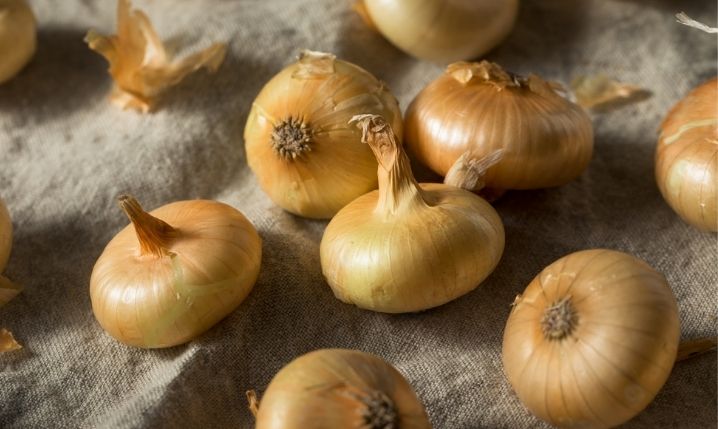With so many onions out there, you can be forgiven for getting confused about their differences. Pearl onions and cipollini onions are two lesser-known onions that you might want to learn more about. Read on to find out all you need to know when it comes to comparing pearl onions vs. cipollini onions.
Contents:
What Are Pearl Onions?

Pearl onions are small onions around 1/4-inch to 1 1/2-inch in size and are widely cultivated in Western Europe, also known as silverskin onions and sometimes baby onions.
In America, the pearl onion is a popular ingredient for soups, stews, relishes, casseroles, sautéeing, pickling, and dishes like succotash.
Pearl onions come in a few varieties: red, white, and brown. The red varieties are milder in flavor than white or brown pearl onions, with a less intense taste. In general, the pearl onion is still sweeter than other types of onions.
You will most often find them sold in the store in large bags or frozen. The most commonly sold variety of pearl onions is white pearl onions which are most used in some of the dishes mentioned above.
What Are Cipollini Onions?

The cipollini onion is an Italian onion, which literally translates to ‘onion.’ They are distinctive-looking small onions with flat tops and bottoms that complete an unmistakable sphere shape.
They are typically around 1-3 inches in total diameter with a yellow paper-thin outer skin.
Cipollini onions are slightly sweeter and milder than most onions, giving them an excellent reputation next to shallots for soups, stews, sautéeing, and for use in various sauces.
They are technically both a yellow onion and a sweet onion variety.
What’s The Difference Between Pearl Onions and Cipollini Onions?
| Pearl Onion | Cipollini Onion |
|---|---|
| A variety of onions. | A type of yellow onion and sweet onion. |
| Best for braising, slow-cooking, sautéeing, and pickling. | Best for soups, stews, sauces, and relishes. |
| Tastes mild and sweet. | Tastes mild and sweet. |
| Small round onions that vary in color. | Small spheres that appear golden-yellow. |
There are some distinctive characteristics of these onions that do set them apart. One big difference is that while both are small onions, cipollini onions are still bigger than pearl onions.
Additionally, the pearl onion is a variety of onions in its own right, with its own types such as red, brown (yellow), and white – much like onions in general. Whereas the cipollini onion is a type of yellow onion and sweet onion.
That being said, they both taste similar and can be used for similar dishes in similar quantities. They are of a similar level of sweetness and should be refrigerated as they are sweet onions. So there’s not much difference between the two besides size and availability.
In most countries, it’s easier to get ahold of pearl onions in the store, so if you’re considering which to use in a recipe and whether they substitute for one another well, the answer is almost certainly to use pearl onions because they’re both good alternatives for one another.
- Size: Pearl onions are around 1-1.5 inches in diameter, whereas cipollini onions are around 1-3 inches in diameter, meaning that sometimes they can be double the size of a pearl onion.
- Appearance: Pearl onions are small, round onions that come in different colors, usually white. Cipollini onions are small, sphere-like onions with flat tops and bottoms that are usually golden-yellow colored.
- Taste: Both of these onions are mild and sweet, with the brown/yellow pearl onions being milder than the red and white varieties.
- Culinary uses: Both of these onions are excellent choices for slow-cooking, relishes, pickling, succotash, sautéeing, and more.
Conclusion
No matter why you want to compare pearl onions vs. cipollini onions, you’ve now got the answers you need. The two onions are both native to Europe, and they’re small onions that are mild and sweet, making excellent ingredients in dishes that require slow-cooking or gentle heating.